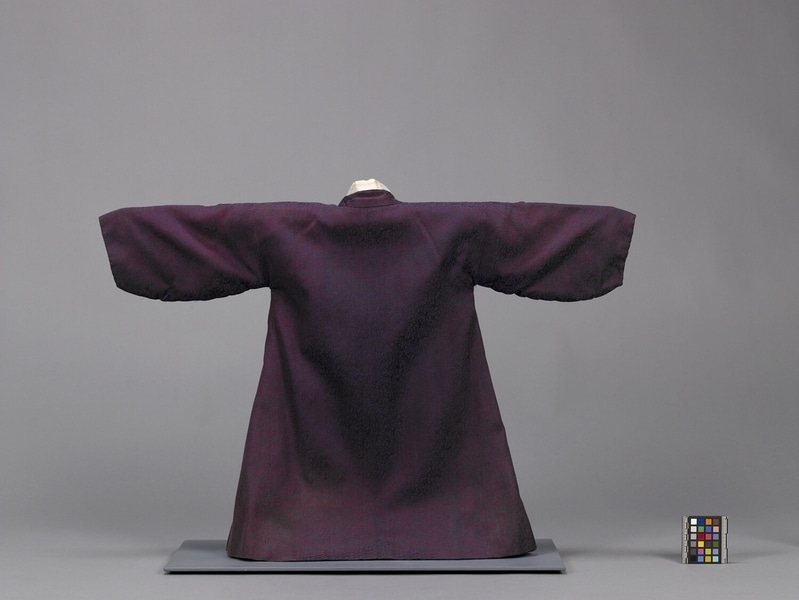Coat Item Number: Ed1.334 from the MOA: University of British Columbia


Description
Purple coat with dark blue floral pattern. The coat has a front opening that overlaps to the left with ties. The coat has a v-neck with outer and inner facings of the same materials with rounded corners at the lower edges. There is a narrower outer facing or collar of white silk squared at the lower ends and sewn in place with invisible stitching. Two wide ribbon ties are attached at the mid-points of the wider facings and there are shorter, narrower ribbon ties on the inside. The sleeves are inset with straight seams and have slight convex curves at their lower edges. The coat has a pair of flared gussets under each arm and a centre back seam. There is a slightly flared panel descending from the mid-point of each outer facing so that the coat overlaps at the front when closed. There are small slits in the side seams at waist level. The inside lining is dark blue rayon.
History Of Use
Such coats “Doo-ru-ma-gui” became a part of men’s and boys’ formal wear in the early- to mid- Chosun Dynasty. At the end of the Chosun Dynasty, the government legislated the simplification of clothing. In the case of the “Doo-ru-ma-gui”, this meant the elimination of slits at the lower end of the side seams, and their replacements with a pair of flared gussets at each side. These often were pleated at the top for comfort. When men and boys began wearing western-style vests with pockets after the opening of Korea to the outside world at the end of the 19th century, “Doo-ru-ma-gui” often were made with slits at waist level so that men could reach objects carried in their vest pockets. “Doo-ru-ma-gui” are still worn as festival wear. In the 1950s they were worn by boys for festivals and to go to school. Those that were less brightly coloured were worn by older boys over eight years of age. In the 1950s the white outer facing or collar was not stiffened with cardboard as it is now, but instead was made of Korean handmade paper or silk.
Specific Techniques
The garment was sewn inside out and then turned right side out, making the seams invisible. It is partly hand-sewn, and partly sewn by machine. The edges of the ribbon ties are cut with pinking shears. One ribbon tie is pieced. The white outer facing or collar is hand-sewn in place.
Narrative
Worn by Mark Elrod as a boy, while living with his family in Korea. Most of the clothing in the J. McRee Elrod Collection was made for him and his family by friends while they were living in Korea, much of it by Kim, Sung Sook. She and her family lived cooperatively in the same house as the Elrod family. While they were there, the Elrods preferred to wear Korean clothing on very cold days and for social occasions. They found it to be more comfortable than western clothing in cold weather, as public buildings were unheated in the period immediately following the Korean War. It also was more comfortable for floor seating in Korean homes, and easier to store with limited furniture than western clothing. The children’s clothing was worn by their children.
Item History
- Made by Sung Sook Kim (Maker) in Seoul, Korea between 1955 and 1960
- Collected between 1955 and 1960
- Owned by Mark Elrod
- Owned by J. McRee Elrod before October 13, 1976
- Received from J. McRee Elrod (Donor) on October 13, 1976
What
- Name
- Coat
- Identification Number
- Ed1.334
- Type of Item
- coat
- Material
- rayon fibre, cotton fibre, wool fibre ? and dye
- Manufacturing Technique
- spun, woven, dyed, cut, sewn and reversed
- Overall
- height 70.0 cm, width 95.0 cm
Who
- Culture
- Korean
- Creator
- Sung Sook Kim (Maker)
- Previous Owner
- Mark Elrod and J. McRee Elrod
- Received from
- J. McRee Elrod (Donor)
Where
- Holding Institution
- MOA: University of British Columbia
- Made in
- Seoul, Korea
When
- Creation Date
- between 1955 and 1960
- Collection Date
- between 1955 and 1960
- Ownership Date
- before October 13, 1976
- Acquisition Date
- on October 13, 1976
Other
- Item Classes
- textiles
- Condition
- good
- Current Location
- Case 77
- Accession Number
- 0335/0015